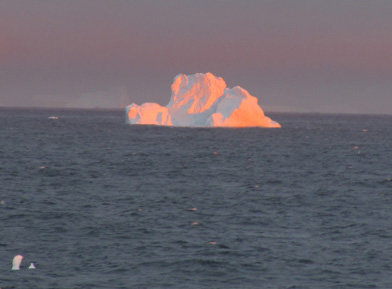
Hey, look, it is Antarctica!
February 5th, 2010
So yesterday we set off for a new site. The last site we were at was over 330 kilometers (over 200 miles) off shore. Now we are 20 kilometers (about 12 miles) offshore. In fact, here is Antarctica!

This site is only in 1000 meters of water (3300 feet), and we are only planning to drill to about 200 meters deep. But this site is so special we are planning on drilling it at least 3 times.
We do this because we usually do not get everything back from the bottom from each core. And this core is so special, we need to make sure we get it all. So we drill 3 or maybe even 4 separate cores, all within 50 meters (165 feet) of each other, to make sure we can put a single ‘composite’ core together.
Now, why is this site so special? Well, remember those diatoms I mentioned a few blogs back? This site, which is called the Adelie Drift, has a lot of diatoms. In fact, the 200 meters we are coring are expected to be over 90% diatoms. This is a very unusual spot, because all of these diatoms have been deposited since the end of the last ice age. Though we usually call the last ice age the “Last Glacial Maximum” or LGM instead.
So the diatoms are why this site is so special, but it’s not that there are so many diatoms. It’s the combination that the diatoms were deposited only since the LGM and are over 200 meters thick. What this means is every year since LGM is a layer of diatoms, just like a tree ring! And since so many diatoms are here, each layer is about 2 cm (just less then an inch) thick.
In fact these layers of diatoms (called diatomite) are so layered, that you can see them with just a photograph, like the one below! Each one of those yellow and brown layers is a year! And there are thousands of these layers.

Now this picture was taken by Rob Dunbar, who is a professor from Stanford, and basically the boss of this particular site. This picture was not taken on board, but rather during a trip Rob led earlier that was the reason he came back. And that we came here at all!
Which means we can use these layers to figure out the climate of this area since the LGM. And we can do it at much, much higher detail then has ever been done before. Nearby on Antarctica we also have another type of core called an “ice core”.
On the JR, when we core we are getting sediments or rocks. In an ice core, they get ice. Antarctica has so much ice, that this ice forms layers. Just like pages in a book, these layers can tell us all kinds of things about the past climate of the earth.
In particular, the ice core that is near us on Antarctica is called the Lawson Ice Core, and it has a lot to tell about the recent history of the earth. So we can use the data we gather from the Adelie Drift, compare it to the Lawson Ice core, and use it to build a better picture of the climate since the LGM.
Now we have a problem with these cores. They are really smelly! They have a lot of something called H2S in them. H2S is what makes rotten eggs smell bad, so the core deck has been smelling like rotten eggs for a few days now. It will not stop us, and we have fans and vents to help keep the smell from getting too bad, but it does make for a stinky day!
Now, normally Lambchop would be talking about the next step in the core on board. But right now she is WAY to busy outside looking at the view! Here she is with Saiko Sugisaki, who was the star of this weeks Wilkes Land video, which is at
www.youtube.com/user/OceanLeadership

I promise to get Lambchop back to work for next time, but can you blame her for being distracted? Just look at this sunrise!


And we had a pair of whales come by and visit too!

Then the weather got a bit rough, and we had an iceberg come over and say “Hi!” It got a little closer then we really wanted it to. This makes the captain nervous, but it does make for a neat picture!

So until next time!